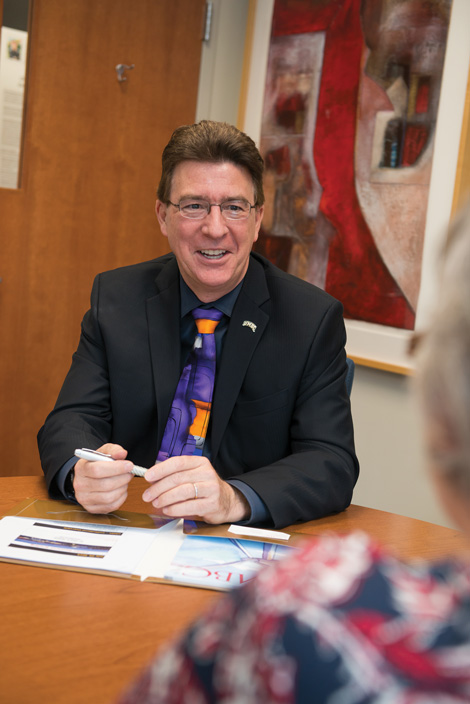UMBC’s growing status as a hub for cybersecurity was highlighted in October by the university’s central role in an award by the U.S. Department of Commerce – National Institute of Standards and Technology (NIST) to the MITRE Corporation for a new Federally Funded Research and Development Center (FFRDC). Where does this activity weave into UMBC’s profile as a research institution? UMBC Magazine talked with Karl V. Steiner, Vice President for Research at UMBC, about the award and the university’s burgeoning research program.
* * * * *
UMBC Magazine: You’ve been at UMBC for a little more than a year now. What attracted you to UMBC, and what are its strengths as a research university?
Karl Steiner: The first thing I heard about UMBC was about its remarkable undergraduate success. The story has been told many times, about its STEM pathways for students and reaching out to underrepresented populations in those fields, and really providing a remarkable overall undergraduate experience. And obviously I knew about President Freeman A. Hrabowski, III, who has positioned the entire institution such that UMBC is now a recognized national leader in this area. The other part that struck me when I first came on campus were the people – the faculty members, the academic leadership and many of the outstanding students I had a chance to meet with. UMBC is an exciting place to come to every morning and the chance to work with the campus community makes this a very exciting opportunity for me and my family.
Once I looked at UMBC in more detail, I realized: “Here’s an institution that has come a long way over the past 20 years but I know it’s ready for another major jump over the next decade or so.
Many great pieces are already in place at UMBC – and I’m calling them “pieces” because I think many of them were not connected quite yet the way I know we can combine them. We are now creating a structure that benefits from our existing strengths in research and scholarship, our national reputation for undergraduate education and our status as a U.S News & World Report number one “up and coming” university for six years in a row. We will continue building UMBC as an institution with a very vibrant, collaborative research and scholarship culture.
What advantages accrue to UMBC from our proximity to Washington, DC, and to the major research hub that has developed between that city and Baltimore?
It is vital for our future plans to have this very rich environment around UMBC – including the proximity of numerous federal laboratories, and to federal and state agencies. Within an hour’s drive of campus we have NASA Goddard, the National Security Agency (NSA), NIST, the Army Research Lab, the Naval Research Lab, the National Institutes of Health (NIH), the National Science Foundation (NSF), the Social Security Administration and the US Department of Education.
Did you know that Maryland as a state has the second highest amount of federal R&D obligations in the Nation? It is a remarkable positioning for our faculty to build meaningful collaborations and partnerships – and provides future employment opportunities for our students.
UMBC’s current research strengths are well aligned with key national priorities such as healthcare, the environment and national security. These topics are not only in the forefront of today’s discussions, but they are long-term issues that won’t be solved over the next five years.
Collaboration seems to be another key strength in UMBC’s research profile
UMBC is a highly collaborative campus. As I like to say: “We play well with others” – both within our campus and with external partners. And as a university, we have always been proactively looking for collaborations. These can be collaborations with federal agencies, with local industry, or with other academic institutions in Maryland and across the country.
It’s a major strength for us as a mid-sized research institution to have so many faculty who go back and forth between departments across colleges. These faculty members actually encourage our academic leadership – including myself, our deans and all the way to Provost Philip Rous and President Hrabowski – to think not only within the academic structure but also within the solution space that we need to find to address major research issues.
It creates an environment where faculty from the social sciences and the humanities can collaborate and provide key solutions. For example, there are ethical questions and social science approaches needed for all of these research segments – especially in the life sciences, but also in climate change, and in cyber-security. None of these challenges can be addressed properly without thinking about the societal context.
Our location close to two major urban centers provides us with many opportunities to pursue our research mission in partnership with our communities, such as our scholarship and creative activity in the arts at Station North in Baltimore or research studies of the urban environment and its impact on underserved neighborhoods.
We have the chance to offer a comprehensive approach to solve some of society’s largest challenges together, which positions UMBC in many ways better than other institutions.
You mentioned some of the key strengths in UMBC’s research profile. What are some of the ways that we’re using those strengths?
One example is the close relationship we’re creating between UMBC and our partner institution, the University of Maryland, Baltimore (UMB), especially in health sciences. UMB has outstanding expertise in such areas as medicine, pharmacy, dentistry and nursing, and in turn our faculty members in such areas as engineering, IT, biology, biochemistry or statistics have unique skills that provide a fertile ground for successful collaborations with our colleagues.
A key to our success in this is that our senior leaders – including President Hrabowski and UMB President Jay Perman – are committed to establishing meaningful and sustainable relationships between our two campuses.
The Partnership Pilot Grants for five collaborations between researchers at UMBC and UMB that we launched last fall set the stage for even deeper relationships, and we’ll announce a second round of Partnership Pilot Grants recipients early next year. I have been impressed by the level of interest expressed by faculty on both campuses as we shared and discussed these opportunities with them.
As an example of the promise of this partnership, there is Mike Summers, a professor of chemistry and biochemistry at UMBC – one of only two Howard Hughes Medical Institute (HHMI) investigators at a public institution in Maryland – who is leading a large research group that is using nuclear magnetic resonance (NMR) techniques to study the structure and function of proteins, such as the AIDS virus. Just a few years ago, Dr. Summers joined with colleagues at UMB and at College Park and together they successfully competed for a major instrumentation grant from NIH for a state-of-the-art 950 Megahertz superconducting NMR instrument. This is what research excellence combined with strategic collaborations can do for us.
In the end, this relationship has to lead to multi-faceted interactions where individual researchers – perhaps a surgeon or a materials researcher for dental implants at UMB – know they can find partners in UMBC’s mechanical engineering or computer sciences departments for a particular orthopedic device, a new test method for materials, or an innovative computer simulation. It might be a partner in our mathematics and statistics department working with so-called Big Data containing 3-D MRI or CT scans or the rapidly growing amount of electronic health records. What we are trying to build is a natural synergy between our two institutions, where research collaborations flourish easily and on multiple levels.
I call this “weaving the fabric” -rather than just building individual bridges.
In what other research areas is UMBC pushing forward into new vistas?
The environmental sciences, clearly. UMBC has a multi-decade history of working closely with NASA Goddard, with over 100 researchers working within three joint centers between UMBC and Goddard. And there’s a significant benefit for our campus by having these very active links between us.
I just returned from a tour over in our Physics Building and saw our LIDAR (Light Detection and Ranging) facility in action, where we conduct research measuring pollution, rainfall, and other environmental factors. So much of that work – and the other work we do with NASA – has a direct impact on our understanding of climate change.
UMBC’s research in this area also extends to the Center for Urban Environmental Research and Education (CUERE), which provides not only a global perspective to the issue of climate change but a true local and regional perspective as well. The director of CUERE, Claire Welty, and her team are looking into environmental, social and economic consequences of the transformation of the urban landscape in and around Baltimore.
Upal Ghosh in UMBC’s chemical and biochemical engineering and Kevin Sowers at our Institute of Marine and Environmental Technology (IMET), located at Baltimore’s Inner Harbor, are successfully working on research in microbial bioremediation to understand the effects and fate of heavy metals and organic pollutants in bays and oceans.
So we have actually a very unique footprint here in research on the environment. Our challenge and our opportunity – I always like combined those two words – are to take that footprint and grow it by working with other institutions, agencies, foundations or the private sector.
While we are talking about the environment and climate change, I should also mention that we’re conducting relevant research into the broader life sciences at a unique facility – the Aquaculture Research Center that we have downtown at the Columbus Center with IMET, led by Russell Hill and Yonathan Zohar.
To my knowledge, there is no other site like this in the world that is able to create sustainable aqua farming from the egg all the way to a harvestable fish. And just like UMBC’s connection to NASA, IMET provides our institution with a way to open the door and create even more collaborative research efforts that actually build communities of excellence.
We have faculty like Govind Rao, director of the Center for Advanced Sensor Technologies (CAST), who is currently working under a major grant from the Defense Advanced Research Projects Agency (DARPA) on ways of literally disrupting the current pharmaceutical manufacturing paradigm by producing drugs in small, portable devices, either at the bedside of the patient – or in the battle field. This is path-breaking research with direct impact on life sciences and beyond.
And then we have Don Norris, director of the Maryland Institute for Policy Analysis and Research (MIPAR), a highly respected leader for scholarly research on policy and policy-related issues in the social sciences and related disciplines. Their work connects the analytic capability of UMBC scholars to the policy issues facing public sector decision makers in the region, state and nation.
Along the same line, our Shriver Center serves as a national leader in applied learning, civic engagement and community-based service delivery programs.
We’ve also developed a considerable reputation in information sciences – especially in what is called “Big Data.” That’s a buzzword that’s been around for some time now, but what it means is that we are working today in Terabytes, Petabytes and even Exabytes – on scales that even just a decade ago were unfathomable. And between Yelena Yesha in computer science and electrical engineering and the Center for Hybrid Multicore Productivity and Research (CHMPR) and Mathias Gobbert’s High Performance Computing Facility (HPCF) in mathematics and statistics, UMBC is well positioned to work with experts in a variety of scientific fields. We’re using our high-performance, big data computing capability to get answers to some of the key research questions out there.
Speaking of information sciences, what does the recent award made by the National Institute of Standards and Technology (NIST) to the MITRE Corporation and the University System of Maryland for a new Federally Funded Research and Development Center (FFRDC) mean for UMBC’s status as a growing hub for cybersecurity research?
I like to say “we were cyber before cyber was cool.” UMBC outstanding professors, including Anupam Joshi, Tim Finin, Charles Nicholas, Alan Sherman, and many others, who work in this field, have positioned UMBC in a very prominent spot within this rapidly growing field of cybersecurity. And we’re also one of the top producers of cybersecurity talent for the NSA, located just 15 miles south of our campus.
It is vital that this new FFRDC is positioned in Maryland. Five or six of the major federal cyber security labs are located in Maryland. We have the NSA obviously. We have the US Cyber Command. We have the Intelligence Advanced Research Projects Agency (IARPA) and the Defense Information Systems Agency Headquarters (DISA). And last year, NIST created the National Cybersecurity Center of Excellence (NCCoE), with a focus on cybersecurity issues in the private sector, which now coordinates our joint efforts on the FFRDC.
This new FFRDC is even more vital for UMBC. As I said earlier, all of these centers are within less than an hour’s drive from our campus. It literally positions us in the middle of everything. So – we are in a perfect location and we have outstanding faculty and remarkable students. And more than half of the companies in bwtech@UMBC – our research park – are cyber related. We have an incredibly strong cyber footprint as an institution within a state that itself has a national reputation as a leader in cybersecurity.
As a campus, I think we will benefit tremendously from this form of collaboration with NIST, with MITRE and with our colleagues at College Park. We will be at the table when many of the key questions are being discussed. And this is vital, because unless you are in the room, and you’re at the table, you will not even be aware of many of the challenges and opportunities that are facing us.
NIST is, by its national mandate, a measurement standard laboratory focused on working with the private sector and developing buy-in and adaptation from the community into agreed-upon practices. It’s a way of working together that lends itself to building a strong partnership between NIST, the private sector and academic leaders, all of whom provide advanced thinking on these issues.
As one of the two leading academic partners – together with College Park – we will be coordinating the interactions with our affiliate academic partners, including George Mason University, the Massachusetts Institute of Technology, Purdue University, the University of Alabama Birmingham, the University of California Berkeley, the University of Delaware, the University of Illinois at Urbana-Champaign and the University of Texas campuses in Dallas and in San Antonio.
Where do you see UMBC as a research institution in the next five years?
I expect that UMBC will continue to be known as an institutional leader providing outstanding opportunities for our undergraduates. But we also want to be known as an institution that has remarkable and talented faculty members who are engaged in world-class research, scholarship and creative activity. By growing this pool of talent, we will attract a very strong group of both graduate students and post-doctoral researchers. These growing research and graduate programs will have a direct and positive impact on the experience of our undergraduates.
Increased funding will be one outcome of this direction, but even more important is to grow and recognize the strong research culture embedded in our institutional fabric. But so is UMBC being at the head of the table when possible solutions to the challenges of today and tomorrow are being discussed. That will bring in an increasing number of talented researchers from across the country and even across the globe to participate in these very exciting endeavors. And in the long term, it will create opportunities that will lead to more collaboratively funded research efforts, new spin-offs and, therefore, new economic growth for our state.
– Richard Byrne ’86
Tags: Fall 2014




